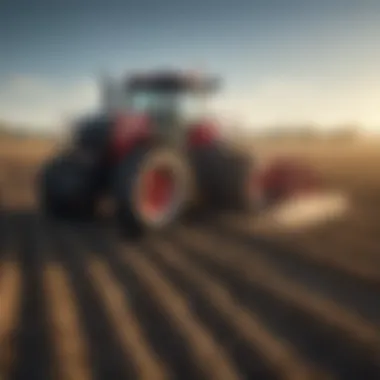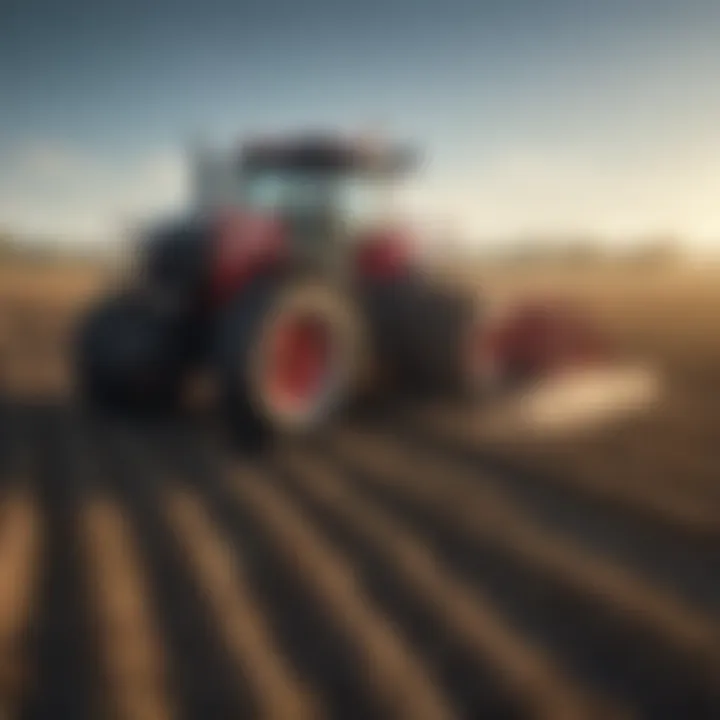Exploring Recent Advances in Agriculture Today


Overview of the Topic
Agriculture stands as a backbone for societies everywhere, playing a critical role in our daily sustenance and economic stability. It encompasses the science, art, and practice of cultivating plants and livestock. The importance of agriculture can’t be underestimated – it feeds the world while providing raw materials for a wide range of industries.
Definition and Importance
Agriculture refers to the cultivation of soil, growing of crops, and rearing of animals for food, fiber, and other products. Its importance is multi-dimensional:
- Food Security: As the global population surges, ensuring a reliable food supply becomes paramount.
- Economic Stability: Agriculture is a significant contributor to GDP in many countries, offering jobs in rural communities.
- Cultural Significance: Many cultures have agriculture deeply embedded in their heritage, influencing customs and traditions.
Current Trends
In today's fast-paced world, recent developments in agriculture are primarily defined by:
- Technological Innovations: The rise of precision agriculture, drones, and sensor technology is reshaping how farmers manage their fields.
- Sustainable Practices: There’s a marked shift toward eco-friendly farming, focusing on sustainability and resource conservation.
- Vertical Farming: Urban settings are being transformed through vertical farming, maximizing space and optimizing crop yield.
Key Techniques and Practices
Understanding key techniques and practices is essential for agricultural advancement. Here are some methods that stand out:
Step-by-Step Guide
- Assess Soil Health: Utilize soil tests to determine pH, nutrient levels, and organic matter content.
- Implement Crop Rotation: Rotate crops to prevent soil depletion and reduce pest infestations.
- Adopt Precision Agriculture: Use technologies like GPS and IoT for better field mapping and resource allocation.
- Integrate Technology: Invest in data analytics to monitor yield, varieties, and weather patterns.
- Harvesting Techniques: Utilize modern harvesting machinery that ensures efficiency and reduces waste.
Tools and Equipment Needed
The agricultural landscape today demands specific tools to keep pace with these developments. Key tools include:
- Drones: For aerial imaging and monitoring crop health.
- Soil Sensors: To assess moisture levels and soil nutrient profiles.
- GPS Technology: To enhance planting and harvesting precision through mapping.
- Automated Machinery: Tractors equipped with AI to facilitate smoother operations.
Challenges and Solutions
While advancements offer great promise, they also come with their share of challenges.
Common Obstacles
- Climate Change: Extreme weather events can disrupt growing seasons and crop yields.
- Resource Scarcity: Water scarcity presents significant hurdles for irrigation and livestock farming.
- Market Fluctuations: Prices can fluctuate wildly, impacting farmers' profitability.
Innovative Solutions
To tackle these challenges, agriculture is exploring innovative solutions:
- Agroecology: This approach seeks to create sustainable and resilient farming systems, incorporating traditional knowledge and practices.
- Genetic Engineering: Developing drought-resistant and disease-resistant crops can help combat climate challenges.
- Community Supported Agriculture (CSA): Building direct connections between farmers and consumers can stabilize market prices and enhance local economies.
"Agriculture is not just a job; it’s a way of life that shapes our communities and our environment. Investing in its development is investing in our future."
Prelude to Current Agricultural Trends
The agricultural world is in the midst of a significant transformation, influenced by various factors ranging from technological breakthroughs to shifts in consumer preferences. This evolution is not merely a trend but a necessary adaptation to the pressing challenges faced by the sector today. Understanding these current trends is crucial for those engaged in farming and agronomy, as it presents a clearer path toward a more sustainable and productive future.
Significance of Agricultural Advancements
Agricultural advancements are pivotal in addressing issues of food security, environmental sustainability, and economic viability. As the global population continues to expand, the demand for efficient food production rises, compelling farmers to adopt more innovative practices. Recent developments in precision agriculture allow for better resource management, reducing waste and increasing yields. For instance, using satellite imagery or soil sensors, farmers can monitor crop health and optimize inputs, ultimately enhancing productivity without over-exploiting resources.
Moreover, these advancements can significantly impact the climate crisis, as they often integrate sustainable practices that minimize environmental footprints. Improvements in irrigation strategies and pest management, for instance, help conserve water and reduce pesticide usage. This is crucial, not just for farming profitability but also for the health of surrounding ecosystems, leading to a more balanced agricultural landscape.
Overview of Global Agricultural Landscape
The global agricultural landscape is diverse and ever-shifting. Countries around the world face unique challenges and opportunities shaped by climate, technology, and consumer demands. In developed nations, high-tech solutions dominate, aiming to streamline production and enhance efficiency. Here, innovations such as drones for crop surveillance or blockchain for traceability in supply chains have gained significant traction. On the contrary, many developing regions struggle with basic infrastructure and access to modern technology, which can stifle progress.
Understanding these varied landscapes helps stakeholders identify potential market opportunities and areas where support and investment are needed. Key players in this dynamic include NGOs promoting sustainable farming practices, governments enacting supportive policies, and educational institutions training the next generation of agricultural leaders.
"The future of agriculture lies not just in the hands of farmers, but also in those who support them—through policy, research, and education."
In summary, delving into current agricultural trends sheds light on not just the practices being employed but also the underlying factors driving these changes. As we navigate this complex field, the interplay between technological innovations and sustainable practices becomes vital, ensuring that agriculture can meet global demand without sacrificing health or ecology.


Technological Innovations in Agriculture
Technological innovations in agriculture are not just flashy gadgets or trendy buzzwords; they represent a critical shift in how food is produced and managed. Such advancements help farmers enhance productivity and increase sustainability across the board. With the ever-changing demands of food supply, a key challenge on the horizon, modern technologies aim to bridge the gap between necessity and capability. By adopting these technologies, growers can respond better to real-time data and environmental shifts, ensuring they make informed decisions that ultimately benefit both their yield and the planet.
Precision Agriculture Technologies
Precision agriculture involves the use of cutting-edge tools to measure and analyze field variability in crops. Think of it as having a tailor-made suit instead of a one-size-fits-all approach. This method not only increases efficiency but also minimizes waste, ensuring that resources like water, fertilizers, and pesticides are used in just the right amounts. Some specific elements include:
- Soil Mapping: Through soil sensors, farmers can map out the nutrient levels and moisture content in very detail, allowing targeted interventions.
- Variable Rate Technology (VRT): This tech enables farmers to apply different amounts of inputs on certain areas of their fields based on the data provided.
The benefits are numerous, from reduced costs to enhanced crop quality. Such practices can yield data that helps farmers forecast yields more accurately, thus optimizing production over time.
Drones and Imaging Techniques
Drones are making waves in agriculture in ways that few could have predicted just a few years ago. For instance, these flying devices equipped with advanced imaging technology provide farmers with aerial views of their fields. This can be a game-changer for monitoring crop health. Using multispectral cameras, farmers can assess plant health, irrigation issues, or pest infestations from above, allowing for targeted responses.
- Crop Monitoring: Continuous assessment enables early detection of issues, making it easier to address them before they escalate.
- Field Mapping: Drones can create highly detailed maps of fields, helping in planning agricultural practices more effectively.
"Drones are now considered the Swiss army knife in a modern farmer's toolkit, providing insights previously thought to be beyond reach."
By embracing drone technology, farmers not only gain efficiency but can also boost their returns on investment significantly.
Blockchain Applications in Agronomy
Blockchain technology is more than just a cornerstone of cryptocurrencies; it’s finding a substantial place in agriculture as well. The distributed ledger technology enhances transparency and traceability throughout the supply chain, which is critical for both producers and consumers.
Here’s how blockchain can benefit agronomy:
- Traceability: Every step—from farm to fork—can be logged on the blockchain, allowing consumers to verify the origins of their food more easily.
- Smart Contracts: These self-executing contracts can streamline transactions between parties, ensuring that conditions are met before payment is rendered.
As consumers become more interested in where their food comes from, blockchain technology could become a deciding factor in purchasing decisions. This trend signals that those engaged in agriculture must adapt to the evolving landscape or risk being left behind.
In summary, technological innovations provide a pathway not simply for growth, but for doing so sustainably. From precision agriculture to drones and blockchain, the future of farming is poised to make significant strides, presenting new challenges and opportunities for those in the field.
Sustainability Practices in Modern Farming
Sustainability in agriculture isn’t just a buzzword tossed around in meetings; it’s becoming a lifeline for farmers navigating the rough seas of contemporary challenges. It encompasses a variety of practices that seek to preserve resources while enhancing crop yields and maintaining soil integrity. With climate change's effects ringing alarm bells across the globe, focusing on sustainable farming means looking towards the future with a practical lens.
The significance of sustainability practices in modern farming can't be overstated. They drive farmers not just to produce, but to cultivate in a manner that preserves the land for generations to come. These practices help in maintaining ecological balance by reducing pollution, conserving water, and ensuring that farming remains viable in a changing climate.
Water Management Strategies
Water is one of the most precious resources in farming. Yet, managing this resource efficiently calls for innovative approaches. Conservation techniques are crucial; practices like drip irrigation and rainwater harvesting have proven highly effective. Drip irrigation delivers water directly to the roots, minimizing evaporation and runoff, which in turn conserves this precious resource.
Additionally, crop selection plays a key role. Farmers can opt for drought-resistant crops that require less water, ensuring productivity without exhausting water sources. Another proactive approach includes implementing soil moisture sensors, which provide real-time data, allowing farmers to irrigate only when necessary.
"Water management is not just about conservation; it’s also about innovation in farming practices that ensure resilience against climate variability."
Soil Health and Regeneration
Healthy soil is the backbone of agriculture. It supports plant life and substantially impacts yield. The focus on soil regeneration—through practices like cover cropping or reduced tillage—helps restore soil vitality. Cover crops, for instance, prevent erosion, improve soil structure, and replenish nutrients.
Regenerative agriculture looks beyond the conventional methods, emphasizing holistic land management. This includes rotating crops to break pest cycles, implementing composting to enrich soil organic matter, and using natural amendments to improve fertility. It’s all about feeding the soil so it can feed the plants, creating a sustainable cycle that can last.
Ecological Pest Management Techniques
In pest control, the traditional methods often involved heavy sprayers and synthetic chemicals. However, the tide is shifting towards ecological pest management. Techniques such as integrated pest management (IPM) employ a range of strategies to keep pests in check. This may involve using beneficial insects or promoting biodiversity to cultivate natural predators.
Farmers are now leaning into practices like crop rotation, which disrupts pest lifecycles, and using barriers to protect crops. Furthermore, encouraging a balance in the ecosystem is crucial to minimize pest outbreaks. Awareness and education about these ecological strategies are key for farmers looking to make an impactful change in pest management while reducing their reliance on harmful chemicals.
In summary, sustainability practices are not merely a trend in modern farming—they are a fundamental shift in how agriculture operates. Effective water management, revitalizing soil health, and embracing ecological pest control reflect a growing recognition that long-term viability connects deeply with environmental stewardship.
Market Dynamics and Economic Impacts
Understanding the market dynamics in agriculture is crucial for grasping the ongoing changes and challenges faced within this sector. The interplay between supply and demand, consumer preferences, and global trade policies significantly influence agricultural outcomes. With robust economic impacts, these dynamics not only shape farmer strategies but also determine the accessibility of food for consumers worldwide.
Agricultural Supply Chain Trends


The agricultural supply chain has seen significant shifts recently, especially with the escalation of technology. Farmers are no longer just producers; they are becoming part of a larger integrated network that includes distributors, retailers, and consumers. This interconnectedness is ushering in greater efficiency but also new challenges.
- Traceability has become paramount. Consumers want to know where their food comes from. This demand pushes producers to adopt transparency in their operations, often requiring advanced tracking technology.
- Local sourcing is another trend gaining traction. With the pandemic emphasizing the importance of community and local economies, many consumers prefer to buy from local farms, which offers fresher produce and reduces transportation costs.
- E-commerce is radically changing the landscape. Farmers are taking to platforms like Facebook to directly sell their goods, cutting out middlemen and potentially increasing their margins.
Adapting to these trends isn’t just wise; it's often necessary for survival. A farmer without a robust online presence may find themselves left in the dust as customers opt for those who can engage in a digital marketplace.
Global Commodity Prices and Trends
Commodity prices are a telling barometer of the agricultural economy. Fluctuations in prices reflect numerous factors, including weather conditions, global demand cycles, and geopolitical tensions. The complexity involved can often boggle the mind; for instance, last year’s drought in major wheat-producing countries caused prices to skyrocket, affecting everything from bread to animal feed.
- Market Volatility: Price swings can be drastic, leading to uncertainty. Farmers must be savvy about when to sell their crops, often needing advanced market analysis tools to time their transactions effectively.
- Foreign Influence: Global economies are tightly interwoven. A shift in trade policy in one country can ripple across the globe, impacting local prices. For example, tariffs can inflate costs and strain relationships among trading partners.
- Investment in Future Trends: An eye on forecasts for agricultural technology, such as biotechnology to create more resilient crop varieties, is essential. As these innovations come to fruition, they may significantly stabilize prices by ensuring consistent yields.
As a farmer, remaining cognizant of these commodity trends can directly impact decision-making processes, ultimately strengthening their financial standing in a competitive marketplace.
"In agricultural economics, understanding the factors that drive market dynamics is essential for making informed decisions that impact both farming success and food security."
In summary, staying updated on market dynamics and economic impacts is not just about observing trends; it's about leveraging this information to one's advantage in the broader agricultural landscape.
Impact of Climate Change on Agriculture
Climate change has become a pivotal player in shaping agriculture today. This issue extends beyond mere statistics and findings; it touches the core of food security, farmer livelihoods, and environmental sustainability. As these changes unfold, the agricultural landscape is under substantial pressure to adapt while ensuring productivity and sustainability. Understanding the significance of climate change impacts is crucial for informed decision-making in farming practices and policy formulation.
Resilient Crop Varieties
The development of resilient crop varieties is a linchpin strategy in the face of climate change. These varieties are specifically bred to withstand the whims of an increasingly erratic climate, such as droughts, floods, and disease outbreaks. Farmers can benefit in several ways:
- Enhanced Yield Stability: Varieties that can endure extreme weather conditions help ensure that crop yields remain consistent, even when times get tough.
- Reduced Resource Inputs: Resilient crops often require fewer inputs, such as water and fertilizers, making them more economical for farmers.
- Biodiversity Conservation: Introducing a variety of resilient crops helps to maintain biodiversity, which in turn enhances ecosystem services crucial for agriculture.
Just take a look at the case of the DroughtGuard corn, which has shown promising results in areas prone to dry spells. These advancements can make a world of difference for farmers facing uncertain weather patterns.
Adaptation Strategies for Farmers
Adaptation strategies are vital for farmers striving to meet the challenges posed by climate change. It's a mix of being proactive and reactive, ensuring that farmers are not just surviving but thriving. Here are some practical approaches:
- Crop Rotation: This technique helps improve soil health and reduce pest pressure, allowing farmers to maintain productivity despite climate challenges. Switching crops can also spread risk and improve returns.
- Water Conservation: Implementing practices like rainwater harvesting or drip irrigation can secure water supplies during dry periods. It’s about making every drop count, especially with unpredictable rainfall.
- Integrating Technology: Utilizing tools such as predictive analytics and weather forecasting apps helps farmers make informed decisions about when to plant, irrigate, or harvest.
"Farmers must embrace change, using innovative strategies to navigate the unpredictable terrain of climate change."
In sum, the impacts of climate change cannot be underestimated. By fostering resilient crop varieties and adopting smart adaptation strategies, farmers will position themselves to remain viable and productive even as environmental challenges mount. Their ability to adapt while maintaining productivity is the cornerstone of a sustainable agricultural future.
Emerging Trends in Horticulture
Horticulture is experiencing a notable shift lately, becoming a focal point in agricultural advancements. With rising populations and a pressing need for sustainable food sources, emerging trends in horticulture not only cater to food demand but also enhance environmental resilience. Embracing these trends can lead to a more efficient production system that benefits farmers and consumers alike. This section delves into two standout trends: vertical farming and hydroponics/aquaponics.
Vertical Farming Initiatives
Vertical farming has caught the eye of many as an innovative approach to food production, particularly in urban areas. This method entails growing crops in stacked layers, often utilizing controlled environments that reduce reliance on soil and natural weather. The significance of vertical farming lies in its potential to:
- Maximize Space: Urban areas struggle with space. Vertical farms use a fraction of what traditional farms require, making food production feasible right where people live.
- Reduce Water Usage: These farms can implement water-efficient systems, often reducing water consumption by up to 95% compared to conventional agriculture.
- Lower Carbon Footprint: With crops produced close to consumers, transportation costs and emissions are significantly decreased.
As urbanization continues, vertical farming presents a practical solution to combat hunger and enhance food security, directly in the heart of cities.
Despite the nascent stage of these initiatives, challenges persist, such as high initial investment and energy costs. This necessitates further exploration into renewable energy and advanced technologies to make vertical farming more sustainable long-term.
Hydroponics and Aquaponics Development
Hydroponics and aquaponics are gaining momentum as sustainable farming techniques that also address food security. Hydroponics involves growing plants in nutrient-rich water solutions, while aquaponics merges hydroponics with aquaculture, creating a symbiotic relationship between fish and plants. The advantages of these methods include:
- Fast Growth Rates: Plants in hydroponic systems often achieve faster growth compared to traditional methods, yielding crops in less time.
- Year-Round Production: Controlled environments allow farmers to produce crops all year, regardless of external weather conditions.
- Fewer Pesticides Required: This method typically involves fewer pests due to the controlled environment, resulting in cleaner products.
Both methods require an understanding of nutrient management and system maintenance, making them suitable for both hobbyists and commercial producers. The growing interest among farmers and entrepreneurs indicates an upward trend in incorporating technology and sustainability into horticultural practices.
In summary, these emerging trends in horticulture promise a blend of ingenuity and sustainability, addressing some of the most pressing challenges in food production. By recognizing the value in techniques like vertical farming and hydroponics/aquaponics, the future of agriculture could be brighter, more sustainable, and capable of feeding the world's population.
Policy and Regulatory Framework


In the era of rapid advancements in agriculture, the policy and regulatory framework plays a pivotal role in shaping the directions and outcomes of farming practices. Regulations are the backbone that ensures not only the safety and quality of agricultural products but also the sustainability of the industry as a whole. They help set the standards that farmers must meet, influence the research and development of new technologies, and ensure that the ecosystem is preserved for future generations.
Government Initiatives and Support
Governments around the globe have stepped up efforts to support the agricultural sector. Various initiatives are in place designed to enhance productivity while also addressing environmental concerns. For instance, subsidies for sustainable farming methods can encourage farmers to adopt practices that benefit both their yield and the ecosystem.
- Research Funding: Many governments allocate significant funds to research institutions aimed at developing new crop varieties, improving soil health, and discovering innovative pest management methods. This ongoing investment ensures that agricultural best practices are informed by scientific evidence.
- Training Programs: Educational initiatives are critical. Training programs provide farmers with the knowledge they need to effectively implement new technologies, understand market demands, and navigate regulatory landscapes. These programs often include workshops and resources on sustainable practices, further equipping farmers to address modern challenges.
Moreover, government backing often comes in the form of grants and loans targeted towards specific projects like precision farming or organic agriculture, ensuring that financial hurdles don't become barriers to essential advancements.
International Agreements on Agriculture
On a broader scale, international agreements on agriculture serve as crucial tools for cooperative development among nations. These agreements typically focus on trade relations, environmental protections, and shared advancements in agricultural technologies. They help harmonize standards and protocols, making it easier for countries to collaborate.
Key points to consider:
- Trade Agreements: They facilitate smoother exchanges of agricultural products across borders. For example, the United States-Mexico-Canada Agreement (USMCA) includes provisions aimed at ensuring that farmers in each country can compete on a level playing field.
- Environmental Standards: International accords often focus on minimizing the ecological footprint of farming. Agreements can set benchmarks for sustainable practices, promoting actions like reduced pesticide use and improved water management.
"By engaging in international cooperation, countries can pool their resources and knowledge, resulting in advancements that benefit everyone involved."
Ultimately, both government initiatives and international agreements form a crucial tapestry in the regulatory landscape of agriculture, supporting innovations and sustainability while addressing the multifaceted challenges faced by farmers today.
Future Directions in Agriculture
The future of agriculture is not just bound to the land or the seasons; it is being shaped by emerging technologies and progressive methodologies. Understanding future directions in agriculture means recognizing how these advancements impact food security, environmental sustainability, and economic viability. The integration of cutting-edge technologies fosters greater efficiencies, enhances productivity, and meets the ever-increasing global demand for food while simultaneously protecting natural resources.
Integrating AI in Farming Practices
Artificial Intelligence, often abbreviated as AI, is carving a niche in the agricultural sector, offering solutions that were previously unthinkable. By employing AI, farmers can harness valuable data to make informed decisions about every aspect of their operations. For instance, AI-driven tools can analyze soil health, predict weather patterns, and optimize planting schedules, allowing farmers to work smarter rather than harder.
One prime example is the use of machine learning algorithms that can identify pest outbreaks by analyzing images from precision cameras installed in the fields. The ability to intervene early not only leads to better crop health but also reduces reliance on pesticides, promoting a more sustainable approach to farming.
Moreover, AI-powered analytics platforms are helping farmers fatigue data overload. These systems transform complex datasets into digestible reports, highlighting key insights that drill down to the nuances of crop performance and market trends. This aids in strategizing not just for the short term but for long-term growth as well.
"AI can help us to predict, understand, and even prevent challenges in agriculture, allowing a shift from reactive to proactive management."
The Role of Biotechnology in Crop Production
Biotechnology is another frontier pushing the boundaries of traditional farming. Through genetic engineering and other welfare practices, it enables the development of crops that can thrive in less-than-ideal conditions. Farmers are increasingly looking towards biotech solutions to enhance productivity—like pest-resistant maize or drought-tolerant wheat. These varieties are designed to tackle specific challenges, ensuring food supply remains stable amid climate fluctuations.
In addition, biotechnological advancements yield products with enhanced nutritional profiles. For instance, genetically modified Golden Rice has been engineered to contain higher levels of Vitamin A, addressing nutrient deficiencies in various populations around the globe.
Furthermore, the rise of CRISPR technology allows for precise genetic adjustments within a fraction of the time compared to traditional crossbreeding methods. This not only speeds up the process of developing new crop varieties but also widens the scope for creating resilient plant species that can adapt to changing climates and resist diseases more effectively.
End and Reflection
The conclusion is often where the threads of thought seen throughout an article come together, providing a chance to reflect on the critical nature of the discussed topics. In this case, the examination of recent developments in agriculture is not merely a review of what has transpired, but a lens through which we can better understand the future of agribusiness. Farming is fundamentally changing, driven by technology, environmental concerns, and the pressing need for sustainable practices. Each of these elements has an intrinsic value that cannot be overlooked.
One of the most significant reflections here is on the necessity for adaptation. Farmers and agricultural professionals must recognize that these advancements are not just trends; they represent a necessary evolution in practice. Like a seed that needs the right conditions to sprout, so too do the innovations require a fertile environment for acceptance and implementation.
"In a rapidly changing world, adaptation is not just beneficial—it's essential."
From the detailed exploration of precision agriculture technologies to the impact of climate change on production methods, understanding these developments is vital. Not only do they enhance productivity, but they also tackle some of the critical challenges faced by the sector today. As farmers engage more with these innovations, they stand to benefit not amethi from increased yields but also from enhanced resilience against market unpredictability and climate uncertainties.
As we look forward, it’s crucial to consider the social implications as well. These advancements should ideally lead to better economic stability for farmers while ensuring food security for all. The intertwined nature of technology, sustainability, and the economy necessitates a holistic view that appreciates each piece as part of a larger puzzle.
Summary of Key Insights
In summation, the recent developments in agriculture unveil several key insights:
- Technological advancements improve efficiency and yield.
- Sustainability practices are essential in the face of climate challenges.
- Emphasizing eco-friendly solutions offers future security for the industry.
- Policy and regulatory frameworks must support innovation while ensuring equity.
The advancements discussed highlight the dynamic nature of agriculture today. It is an era defined not just by yield, but by ethical practices and environmental guardianship.
Call for Continued Innovation
While the present is marked by impressive strides forward, it is imperative to not rest on one’s laurels. The call for continued innovation in agriculture is not just a wish; it is a necessity. Each layer of change must be met with further research, trials, and evaluations.
The agricultural landscape is ripe with opportunity. Here are a few areas that warrant ongoing attention and support:
- Investment in research: Continued funding for agricultural science can lead to breakthroughs in crop resistance and soil health.
- Collaboration between farmers and tech companies: Partnerships can foster innovation tailored to real-world challenges.
- Community engagement: Involve local communities in sustainable practices to adapt new methods effectively.
- Education and training: Ensuring that farmers are equipped with knowledge about novel practices will enhance adoption rates.
To cultivate a sustainable agricultural future, innovation must remain at the forefront. It is through a commitment to continuous improvement that the sector can meet global challenges head-on and emerge stronger.



